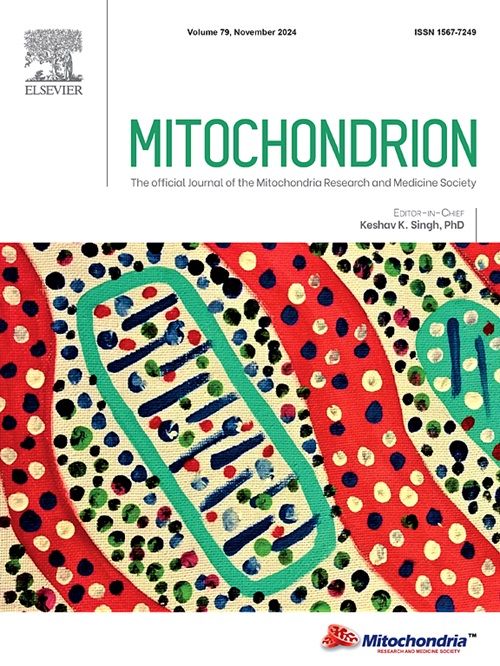自噬增强剂对阿尔茨海默病中β -淀粉样蛋白诱导的线粒体和突触毒性的有益作用
IF 4.5
3区 生物学
Q2 CELL BIOLOGY
引用次数: 0
摘要
我们的研究目的是探讨线粒体自噬增强剂对突变淀粉样前体蛋白(APP)和β淀粉样蛋白(Aβ)诱导的阿尔茨海默病(AD)线粒体和突触毒性的有益作用。二十年来的研究强调了线粒体功能障碍和突触损伤在早发性和晚发性AD发病机制中的关键作用。新出现的证据表明,受损线粒体的清除受损是AD的早期病理事件,将线粒体自噬增强剂定位为潜在的治疗候选者。本研究利用永生化小鼠海马(HT22)神经元,确定了四种线粒体自噬增强剂尿素A (UA)、肌动蛋白、番茄碱和烟酰胺核苷(NR)的最佳剂量。用突变体APP (mAPP) cDNA转染HT22细胞,并用增强子处理。通过评估参与线粒体动力学、生物发生、线粒体自噬和突触功能以及细胞存活和线粒体呼吸的基因的mRNA和蛋白表达水平来评估其效果。同时检测处理和未处理的mAPP-HT22细胞的线粒体形态。结果显示,mAPP-HT22细胞表现出线粒体分裂增加,融合减少,突触和线粒体自噬相关基因下调,细胞存活减少,线粒体呼吸受损,线粒体过度碎片化和缩短。用线粒体自噬增强剂治疗逆转了这些缺陷,恢复了线粒体和突触的健康。观察到细胞存活率提高,线粒体融合、突触和线粒体自噬基因上调,线粒体结构改善,碎片化减少。值得注意的是,UA显示了最强大的缓解效果。这些发现强调了线粒体自噬增强剂的治疗潜力,特别是UA,作为治疗阿尔茨海默病线粒体和突触功能障碍的有希望的候选者。本文章由计算机程序翻译,如有差异,请以英文原文为准。
Beneficial effects of mitophagy enhancers on amyloid beta-induced mitochondrial and synaptic toxicities in Alzheimer’s disease
The purpose of our study is to investigate the beneficial effects of mitophagy enhancers against mutant amyloid precursor protein (APP) and amyloid beta (Aβ) induced mitochondrial and synaptic toxicities in Alzheimer’s disease (AD). Research spanning over two decades highlights the critical role of mitochondrial dysfunction and synaptic damage in the pathogenesis of both early-onset and late-onset AD. Emerging evidence suggests impaired clearance of damaged mitochondria is an early pathological event in AD, positioning mitophagy enhancers as potential therapeutic candidates. This study determined the optimal doses of four mitophagy enhancers—Urolithin A (UA), actinonin, tomatidine, and nicotinamide riboside (NR)—using immortalized mouse hippocampal (HT22) neurons. HT22 cells were transfected with mutant APP (mAPP) cDNA and treated with the enhancers. The effects were assessed by evaluating mRNA and protein expression levels of genes involved in mitochondrial dynamics, biogenesis, mitophagy, and synaptic function, alongside cell survival and mitochondrial respiration. Mitochondrial morphology was also examined in treated and untreated mAPP-HT22 cells. Results showed that mAPP-HT22 cells exhibited increased mitochondrial fission, reduced fusion, downregulated synaptic and mitophagy-related genes, diminished cell survival, impaired mitochondrial respiration, and excessively fragmented, shortened mitochondria. Treatment with mitophagy enhancers reversed these deficits, restoring mitochondrial and synaptic health. Enhanced cell survival, upregulation of mitochondrial fusion, synaptic, and mitophagy genes, improved mitochondrial structure, and reduced fragmentation were observed. Notably, UA demonstrated the most robust mitigating effects. These findings underscore the therapeutic potential of mitophagy enhancers, particularly UA, as promising candidates to treat mitochondrial and synaptic dysfunctions in AD.
求助全文
通过发布文献求助,成功后即可免费获取论文全文。
去求助
来源期刊

Mitochondrion
生物-细胞生物学
CiteScore
9.40
自引率
4.50%
发文量
86
审稿时长
13.6 weeks
期刊介绍:
Mitochondrion is a definitive, high profile, peer-reviewed international research journal. The scope of Mitochondrion is broad, reporting on basic science of mitochondria from all organisms and from basic research to pathology and clinical aspects of mitochondrial diseases. The journal welcomes original contributions from investigators working in diverse sub-disciplines such as evolution, biophysics, biochemistry, molecular and cell biology, genetics, pharmacology, toxicology, forensic science, programmed cell death, aging, cancer and clinical features of mitochondrial diseases.
 求助内容:
求助内容: 应助结果提醒方式:
应助结果提醒方式:


